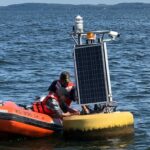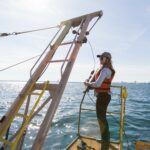About GLOS
The School of Freshwater Sciences (SFS) currently operates 3 seasonal environmental monitoring buoys in Lake Michigan as part of the Great Lakes Observing System (GLOS). Historically, two monitoring buoys have been deployed off of Atwater Beach in Milwaukee, WI. As of 2019, only 1 buoy at the 20-meter depth site will continue to be deployed. The larger 10-meter buoy is considered to be retired. Another monitoring buoy is located in south-central Green Bay, WI. Green Bay monitoring is conducted in collaboration with the Fox-Wolf Watershed Alliance (FWWA) and affiliated partners. SFS also conducts environmental research and monitoring in collaboration with the US National Park Service at Sleeping Bear Dunes National Lakeshore, where an additional buoy is deployed seasonally, and the Apostle Islands National Lakeshore. Additional environmental monitoring of Lake Michigan is conducted in collaboration with the Lake Express high-speed ferry as well as the North Shore Water Commission.
These monitoring programs produce a variety of data including over-lake weather measurements, wave height, current speed and direction, and water quality measurements such as temperature, conductivity, oxygen concentration, carbon dioxide concentration, pH, and chlorophyll concentration. Each buoy is also equipped with either a surface or benthic camera, which transmits images at 10 minute intervals to our Dashboard page.
The overall objective of this GLOS effort is to increase Lake Michigan observing capacity, which will lead to improved wave forecasting, over-lake weather forecasting, and circulation modeling. The monitoring systems also provide data for the validation and improvement of air quality (ozone) forecast models, monitoring of long-term changes in nearshore water quality, and water quality decision support tools for managers at the municipal, state and federal levels.
News
- Local Documentary Filmmaker Captures Green Bay Buoy LaunchLocal documentary features the University of Wisconsin- Milwaukee's School of Freshwater Science's Green Bay buoy launch.
- UWM-SFS’s Jessie Grow Featured in GLOS/Seagull Users LivestreamJessie Grow, Research Specialist from University of Wisconsin Milwaukee, featured in GLOS/Seagull user livestream.
- WISN12 News Joins SFS Neeskay Crew for Atwater Buoy LaunchWISN 12 was onboard as the crew got onto the water, preparing to deploy the first buoy of the season.
- jgrow@uwm.edu
- 414-382-1700
- GLRF Main Building 180





